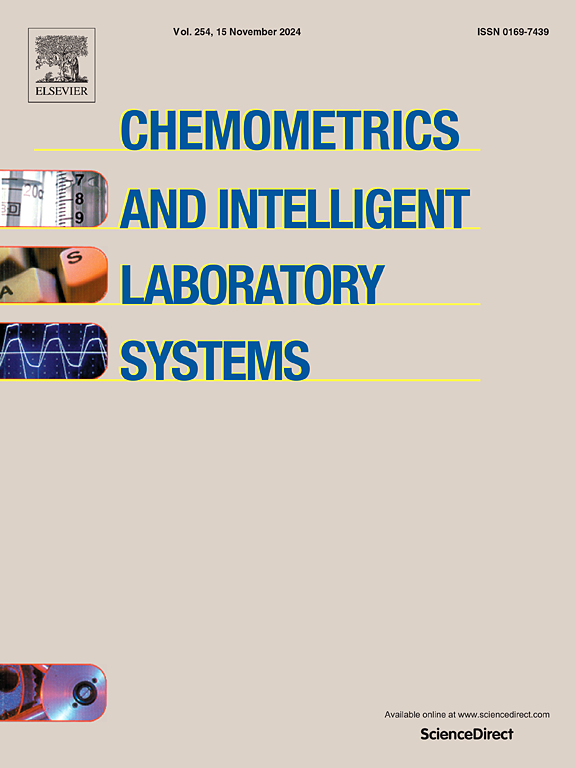基于拉曼光谱和KPCA特征提取的集成学习的变压器绝缘油无损老化评价
IF 3.8
2区 化学
Q2 AUTOMATION & CONTROL SYSTEMS
Chemometrics and Intelligent Laboratory Systems
Pub Date : 2025-08-23
DOI:10.1016/j.chemolab.2025.105514
引用次数: 0
摘要
变压器绝缘油老化严重影响电力系统的可靠性。本文提出了一种基于核主成分分析(KPCA)和集成学习的拉曼光谱无损老化评价方法。通过加速热老化实验和光谱检测平台获得拉曼光谱数据;随后,使用移动平均滑动、Savitzky-Golay和高斯滤波对数据进行预处理。然后,利用4个核函数(Linear、Polynomial、Gaussian和Sigmoid)的KPCA提取拉曼特征,并利用决策树对评价性能进行比较;最后,将四种弱分类器(DT、LDA、SVM和BPNN)集成在一起,构建最终的集成学习评价模型。结果表明:高斯滤波的信噪比最高,为35.23 dB;高斯核KPCA的特征提取效果最好,平均准确率达到96.88%;BPNN集成学习评价模型准确率最高,达到99.6%。除了验证KPCA在特征提取方面的优势和模型的鲁棒性外,本研究还与传统的主成分分析(PCA)方法进行了对比测试,并在测试集中引入了不同类型和强度的噪声。研究发现,该模型能有效评估变压器绝缘油的老化状态,具有较高的抗干扰能力,为改进变压器运行状态监测提供了一种新的方法。本文章由计算机程序翻译,如有差异,请以英文原文为准。
Non-destructive aging evaluation of transformer insulation oil via Raman spectroscopy and ensemble learning with KPCA feature extraction
Transformer insulating oil aging critically impacts power system reliability. This study develops a non-destructive aging evaluation method using Raman spectroscopy with kernel principal component analysis (KPCA) and ensemble learning. Raman spectral data were obtained through accelerated thermal aging experiments and a spectral detection platform; subsequently, the data were preprocessed using Moving Average Sliding, Savitzky-Golay, and Gaussian filtering. Then, Raman features were extracted using KPCA with four kernel functions (Linear, Polynomial, Gaussian and Sigmoid), and evaluation performance was compared using a decision tree; eventually, four weak classifiers (DT, LDA, SVM, and BPNN) were integrated to construct the final ensemble learning evaluation model. Results showed Gaussian filtering achieved the highest signal-to-noise ratio (35.23 dB); Gaussian kernel KPCA yielded the best feature extraction, achieving 96.88 % average accuracy; and the BPNN ensemble learning evaluation model delivered the highest accuracy of 99.6 %. In addition to verifying the benefits of KPCA in feature extraction and the robustness of the model, this study conducted a comparative test with traditional principal component analysis (PCA) methods and introduced various types and intensities of noise into the test set. The study found that the model can effectively evaluate the aging state of transformer insulating oil and has high anti-interference capabilities, providing a new method for improving transformer operating status monitoring.
求助全文
通过发布文献求助,成功后即可免费获取论文全文。
去求助
来源期刊
CiteScore
7.50
自引率
7.70%
发文量
169
审稿时长
3.4 months
期刊介绍:
Chemometrics and Intelligent Laboratory Systems publishes original research papers, short communications, reviews, tutorials and Original Software Publications reporting on development of novel statistical, mathematical, or computer techniques in Chemistry and related disciplines.
Chemometrics is the chemical discipline that uses mathematical and statistical methods to design or select optimal procedures and experiments, and to provide maximum chemical information by analysing chemical data.
The journal deals with the following topics:
1) Development of new statistical, mathematical and chemometrical methods for Chemistry and related fields (Environmental Chemistry, Biochemistry, Toxicology, System Biology, -Omics, etc.)
2) Novel applications of chemometrics to all branches of Chemistry and related fields (typical domains of interest are: process data analysis, experimental design, data mining, signal processing, supervised modelling, decision making, robust statistics, mixture analysis, multivariate calibration etc.) Routine applications of established chemometrical techniques will not be considered.
3) Development of new software that provides novel tools or truly advances the use of chemometrical methods.
4) Well characterized data sets to test performance for the new methods and software.
The journal complies with International Committee of Medical Journal Editors'' Uniform requirements for manuscripts.

 求助内容:
求助内容: 应助结果提醒方式:
应助结果提醒方式:


